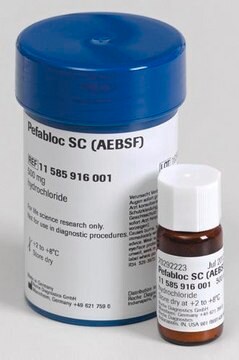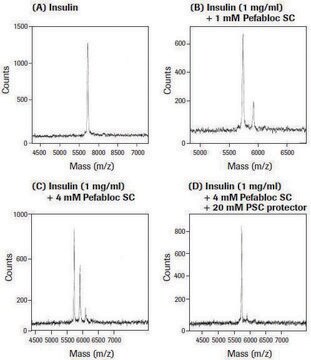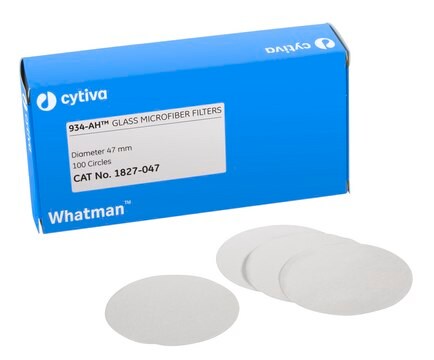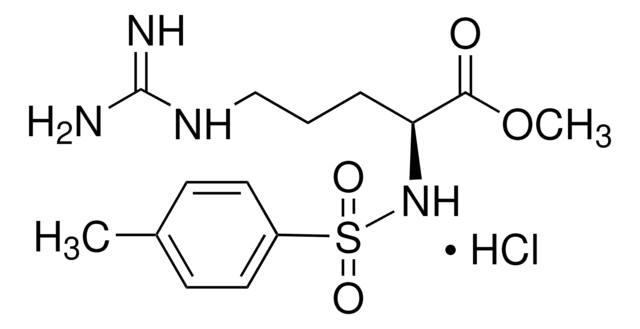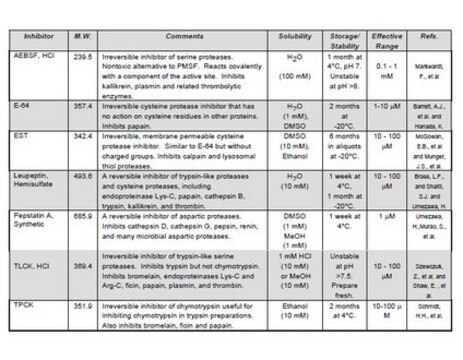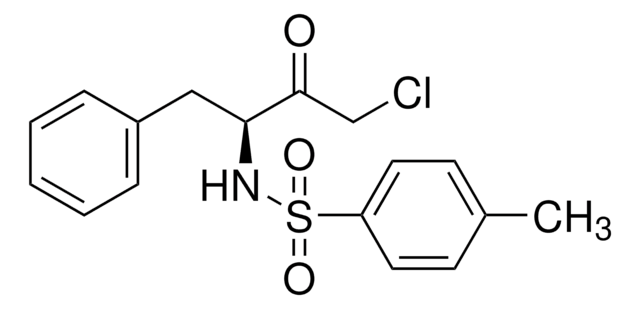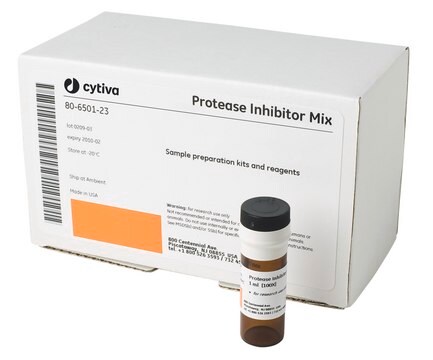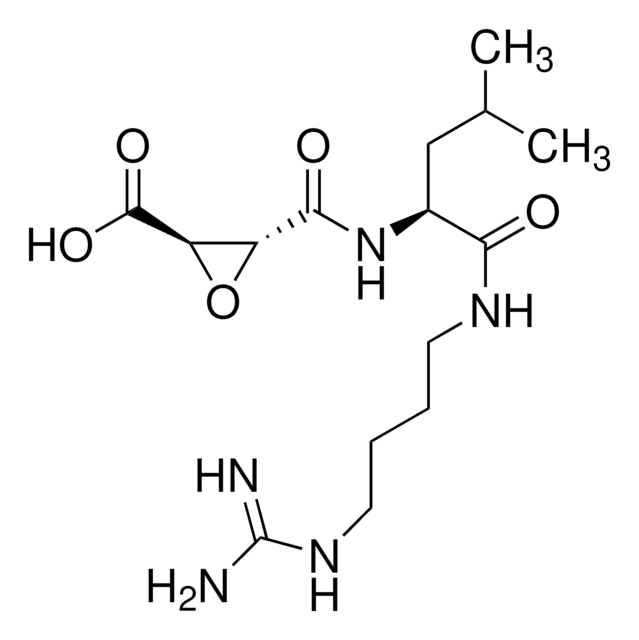11873601001
Roche
794 SC PLUS
crystalline, suitable for blocking, suitable for protein purification, 0.1-1.0 mg/mL
Synonim(y):
inhibitor proteazy serynowej, pefabloc
Zaloguj sięWyświetlanie cen organizacyjnych i kontraktowych
About This Item
Kod UNSPSC:
12352204
Polecane produkty
Formularz
crystalline
Poziom jakości
masa cząsteczkowa
239.5
opakowanie
pkg of 5 mL (100 mg)
producent / nazwa handlowa
Roche
stężenie
0.1-1.0 mg/mL
metody
blocking: suitable
protein purification: suitable
optymalne pH
neutral
mp
175-185 °C
rozpuszczalność
soluble (Solubility and stability of the protease inhibitor remains unchanged.)
temp. przechowywania
2-8°C
Opis ogólny
Pefabloc SC is a specific, potent, and irreversible inhibitor of serine proteases. The inhibitory activity is comparable to PMSF or DFP, but Pefabloc SC is nontoxic to cells. The Pefabloc SC PLUS set combines the serine protease inhibitor Pefabloc SC with a uniquely formulated Pefabloc SC protector (PSC-Protector), adding additional convenience and reliability to the safe, stable protease inhibition provided by Pefabloc SC.
Recent findings indicate that sulfonyl-type serine protease inhibitors such as Pefabloc SC and PMSF can bind covalently to proteins. This can occur when the inhibitors are used in high concentrations, or during extended incubation times under alkaline conditions. This interaction adversely affects the tyrosine and lysine residues of a protein, as well as the free amino terminus. The PLUS additive (PSC-Protector) included with this set prevents covalent attachment of Pefabloc SC to proteins when used in higher concentrations and extended incubation times at an alkaline pH.
Recent findings indicate that sulfonyl-type serine protease inhibitors such as Pefabloc SC and PMSF can bind covalently to proteins. This can occur when the inhibitors are used in high concentrations, or during extended incubation times under alkaline conditions. This interaction adversely affects the tyrosine and lysine residues of a protein, as well as the free amino terminus. The PLUS additive (PSC-Protector) included with this set prevents covalent attachment of Pefabloc SC to proteins when used in higher concentrations and extended incubation times at an alkaline pH.
Specyficzność
Pefabloc SC belongs to the family of sulfonyl fluorides which irreversibly block serine proteases. Pefabloc was also described as potent serine threonine phosphatase inhibitor.
Specific, potent, and irreversible inhibitor of serine proteases. The inhibitory activity of Pefabloc SC is comparable to PMSF or DFP; however, Pefabloc SC is non-toxic. Specifically inhibits serine proteases and prevents nonspecific covalent modification of proteins as tested by mass spectrometry.
Zastosowanie
- Pefabloc® SC is used to inhibit the detrimental effects of proteases during preparative protein purification. The PSC-protector solution prevents nonspecific covalent modification of proteins when Pefabloc is used in higher concentrations and extended incubation times at an alkaline pH (tested by mass spectrometry).
- Due to its low toxicity toward eukaryotic cells, it may be applied in the production of recombinant proteins, during fermentation of transformed cells, where proteolytic digestion may decrease the yield of the desired product.
- Pefabloc SC is used to completely inactivate proteinase K during the preparation of chromosomal DNA in agarose plugs. For this purpose, the cells are embedded in agarose and digested with proteinase K to degrade all proteins. Before a specific restriction endonuclease is added, the proteinase K is inactivated by incubating the agarose plugs in 1 – 5 mM Pefabloc SC in 10 mM Tris-HCl, 1 mM EDTA , pH 7 for 2 hours at +37 °C or overnight.
- In contrast to PMSF, Pefabloc SC is an excellent blocker of thrombin activity in serum or plasma. In these biological fluids, PMSF interacts in a reversible manner with albumin, which reduces its free concentration and leads to a delay in thrombin inactivation. Pefabloc SC, however, does not react with serum albumin, and exhibits a threefold higher capacity to inactivate thrombin under similar conditions.
- Pefabloc SC can be used on living cells.
Pefabloc® SC PLUS has been used in digitonin extraction buffer and in cathepsin B activity assay buffer in THP-1 cells. It has also been used as a component of iodixanol solution and sucrose buffer for the isolation of nuclei from Xenopus embryos.
Cechy i korzyści
- Take advantage of a simplified two-reagent system. Use the PSC-Protector solution to prevent covalent binding between proteins and Pefabloc SC, even at high concentrations, extended incubation times, and at alkaline pH.
- Benefit from an easy-to-use inhibitor. Add water-soluble Pefabloc SC directly to aqueous buffers.
- Avoid hazardous compounds. Obtain non-toxic protease inhibition without risk to you, or those around you.
- Ensure protection with improved stability. Achieve consistent protease inhibition even at pH levels above 7.0 and temperatures above +4°C.
- Maximize inhibition. Be certain that your levels of active inhibitor are high enough by using a product that is reliably soluble and stable.
Opakowanie
Set containing two components
Uwaga dotycząca przygotowania
Working concentration: 0.1 - 1.0 mg/ml (0.4 - 4 mM)
Pefabloc SC plus the corresponding amount of PSC-protector
Working solution: Recommended solvent is distilled water or aqueous buffer (for Pefabloc SC).
The solubility is up to 0.1 M for Pefabloc SC.
Storage conditions (working solution): -15 to -25 °C (stock solution)
Solubility and stability of the protease inhibitor remains unchanged. See Pefabloc SC.
Pefabloc SC plus the corresponding amount of PSC-protector
Working solution: Recommended solvent is distilled water or aqueous buffer (for Pefabloc SC).
The solubility is up to 0.1 M for Pefabloc SC.
Storage conditions (working solution): -15 to -25 °C (stock solution)
Solubility and stability of the protease inhibitor remains unchanged. See Pefabloc SC.
Rekonstytucja
Solubility and stability of the protease inhibitor remains unchanged. See Pefabloc SC.
Inne uwagi
For life science research only. Not for use in diagnostic procedures.
Informacje prawne
Pefabloc is a registered trademark of Pentapharm
Ta strona może zawierać tekst przetłumaczony maszynowo.
Tylko elementy zestawu
Numer produktu
Opis
- Pefabloc SC, 100 mg
- PSC-Protector solution, 5 mL ready-to-use
Hasło ostrzegawcze
Danger
Zwroty wskazujące rodzaj zagrożenia
Zwroty wskazujące środki ostrożności
Klasyfikacja zagrożeń
Eye Dam. 1 - Flam. Liq. 3 - Skin Corr. 1B
Kod klasy składowania
3 - Flammable liquids
Klasa zagrożenia wodnego (WGK)
WGK 1
Wybierz jedną z najnowszych wersji:
Masz już ten produkt?
Dokumenty związane z niedawno zakupionymi produktami zostały zamieszczone w Bibliotece dokumentów.
Klienci oglądali również te produkty
DNase-seq to study chromatin accessibility in early Xenopus tropicalis embryos
Cho JS, et al.
Cold Spring Harbor Protocols, 4 (2019)
Yonggang Zhang et al.
Oncotarget, 6(8), 6160-6178 (2015-02-24)
Regulatory mechanisms underlying constitutive and inducible NFκB activation in cancer remain largely unknown. Here we investigated whether a novel NIK- and IKK2-binding protein (NIBP) is required for maintaining malignancy of cancer cells in an NFκB-dependent manner. Real-time polymerase chain reaction
Chikodili C Nduaguibe et al.
Islets, 2(3), 200-206 (2010-11-26)
Pefabloc, Trasylol and Urinary Trypsin Inhibitor (UTI) have been reported to be effective serine protease inhibitors that impair pancreatic endogenous proteases resulting in improved islet yield. Here we evaluated the effect of these inhibitors on endogenous proteases (trypsin, chymotrypsin and
Nicolai J Wewer Albrechtsen et al.
Endocrine connections, 4(1), 50-57 (2015-01-18)
To investigate the stability of glucagon-like peptide 1 (GLP-1) and glucagon in plasma under short- and long-term storage conditions. Pooled human plasma (n=20), to which a dipeptidyl peptidase 4 (DPP4) inhibitor and aprotinin were added, was spiked with synthetic GLP-1
Niclosamide activates the NLRP3 inflammasome by intracellular acidification and mitochondrial inhibition
Tran UT and Kitami T
Communications biology, 2(1), 2-2 (2019)
Nasz zespół naukowców ma doświadczenie we wszystkich obszarach badań, w tym w naukach przyrodniczych, materiałoznawstwie, syntezie chemicznej, chromatografii, analityce i wielu innych dziedzinach.
Skontaktuj się z zespołem ds. pomocy technicznej